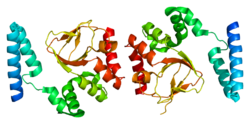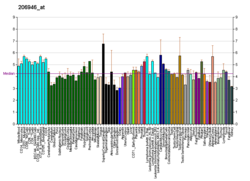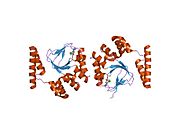HCN4
Appearance
Potassium/sodium hyperpolarization-activated cyclic nucleotide-gated channel 4is aproteinthat in humans is encoded by theHCN4gene.[5][6][7][8]
There are fourHCN channels.HCN4 is prominently expressed in thepace makerregion of the mammalianheart.[9]Some humans withbradycardiaandSick sinus syndromehave been shown to have mutations in their HCN4 gene.[10][11][12]The role of HCN channels inautonomiccontrol of heart rate is currently a matter of ongoing investigation.[13][14][15][16]
Interactions
[edit]HCN4 has been shown tointeractwithHCN2.[17]
See also
[edit]References
[edit]- ^abcGRCh38: Ensembl release 89: ENSG00000138622–Ensembl,May 2017
- ^abcGRCm38: Ensembl release 89: ENSMUSG00000032338–Ensembl,May 2017
- ^"Human PubMed Reference:".National Center for Biotechnology Information, U.S. National Library of Medicine.
- ^"Mouse PubMed Reference:".National Center for Biotechnology Information, U.S. National Library of Medicine.
- ^Ludwig A, Zong X, Stieber J, Hullin R, Hofmann F, Biel M (May 1999)."Two pacemaker channels from human heart with profoundly different activation kinetics".The EMBO Journal.18(9): 2323–9.doi:10.1093/emboj/18.9.2323.PMC1171315.PMID10228147.
- ^Seifert R, Scholten A, Gauss R, Mincheva A, Lichter P, Kaupp UB (Aug 1999)."Molecular characterization of a slowly gating human hyperpolarization-activated channel predominantly expressed in thalamus, heart, and testis".Proceedings of the National Academy of Sciences of the United States of America.96(16): 9391–6.Bibcode:1999PNAS...96.9391S.doi:10.1073/pnas.96.16.9391.PMC17793.PMID10430953.
- ^Hofmann F, Biel M, Kaupp UB (Dec 2005). "International Union of Pharmacology. LI. Nomenclature and structure-function relationships of cyclic nucleotide-regulated channels".Pharmacological Reviews.57(4): 455–62.doi:10.1124/pr.57.4.8.PMID16382102.S2CID45853869.
- ^"Entrez Gene: HCN4 hyperpolarization activated cyclic nucleotide-gated potassium channel 4".
- ^Baruscotti M, Bucchi A, Viscomi C, Mandelli G, Consalez G, Gnecchi-Rusconi T, Montano N, Casali KR, Micheloni S, Barbuti A, DiFrancesco D (Jan 2011)."Deep bradycardia and heart block caused by inducible cardiac-specific knockout of the pacemaker channel gene Hcn4".Proceedings of the National Academy of Sciences of the United States of America.108(4): 1705–10.Bibcode:2011PNAS..108.1705B.doi:10.1073/pnas.1010122108.PMC3029742.PMID21220308.
- ^Jou, Chuanchau J.; Arrington, Cammon B.; Barnett, Spencer M; Shen, Jiaxiang; Cho, Scott; Sheng, Xiaoming; McCullagh, Patrick C.; Bowles, Neil E.; Pribble, Chase M.; Saarel, Elizabeth V.; Pilcher, Thomas A.; Etheridge, Susan P.; Tristani-Firouzi, Martin (2017)."A Functional Assay for Sick Sinus Syndrome Genetic Variants".Cellular Physiology and Biochemistry.42(5): 2021–2029.doi:10.1159/000479897.ISSN1015-8987.PMID28803248.
- ^Schulze-Bahr E, Neu A, Friederich P, Kaupp UB, Breithardt G, Pongs O, Isbrandt D (May 2003)."Pacemaker channel dysfunction in a patient with sinus node disease".The Journal of Clinical Investigation.111(10): 1537–45.doi:10.1172/JCI16387.PMC155041.PMID12750403.
- ^Laish-Farkash A, Glikson M, Brass D, Marek-Yagel D, Pras E, Dascal N, Antzelevitch C, Nof E, Reznik H, Eldar M, Luria D (Dec 2010)."A novel mutation in the HCN4 gene causes symptomatic sinus bradycardia in Moroccan Jews".Journal of Cardiovascular Electrophysiology.21(12): 1365–72.doi:10.1111/j.1540-8167.2010.01844.x.PMC3005590.PMID20662977.
- ^Larsson HP (Sep 2010)."How is the heart rate regulated in the sinoatrial node? Another piece to the puzzle".The Journal of General Physiology.136(3): 237–41.doi:10.1085/jgp.201010506.PMC2931147.PMID20713549.
- ^Schweizer PA, Duhme N, Thomas D, Becker R, Zehelein J, Draguhn A, Bruehl C, Katus HA, Koenen M (Oct 2010)."cAMP sensitivity of HCN pacemaker channels determines basal heart rate but is not critical for autonomic rate control".Circulation: Arrhythmia and Electrophysiology.3(5): 542–52.doi:10.1161/CIRCEP.110.949768.hdl:11858/00-001M-0000-002C-5DAB-C.PMID20693575.
- ^Liao Z, Lockhead D, Larson ED, Proenza C (Sep 2010)."Phosphorylation and modulation of hyperpolarization-activated HCN4 channels by protein kinase A in the mouse sinoatrial node".The Journal of General Physiology.136(3): 247–58.doi:10.1085/jgp.201010488.PMC2931151.PMID20713547.
- ^Nof E, Antzelevitch C, Glikson M (Jan 2010)."The Contribution of HCN4 to normal sinus node function in humans and animal models".Pacing and Clinical Electrophysiology.33(1): 100–6.doi:10.1111/j.1540-8159.2009.02563.x.PMC2865562.PMID19796353.
- ^Much B, Wahl-Schott C, Zong X, Schneider A, Baumann L, Moosmang S, Ludwig A, Biel M (Oct 2003)."Role of subunit heteromerization and N-linked glycosylation in the formation of functional hyperpolarization-activated cyclic nucleotide-gated channels".The Journal of Biological Chemistry.278(44): 43781–6.doi:10.1074/jbc.M306958200.PMID12928435.
Further reading
[edit]- Qu J, Altomare C, Bucchi A, DiFrancesco D, Robinson RB (Aug 2002). "Functional comparison of HCN isoforms expressed in ventricular and HEK 293 cells".Pflügers Archiv.444(5): 597–601.doi:10.1007/s00424-002-0860-7.PMID12194012.S2CID508732.
- Schulze-Bahr E, Neu A, Friederich P, Kaupp UB, Breithardt G, Pongs O, Isbrandt D (May 2003)."Pacemaker channel dysfunction in a patient with sinus node disease".The Journal of Clinical Investigation.111(10): 1537–45.doi:10.1172/JCI16387.PMC155041.PMID12750403.
- Stieber J, Thomer A, Much B, Schneider A, Biel M, Hofmann F (Sep 2003)."Molecular basis for the different activation kinetics of the pacemaker channels HCN2 and HCN4".The Journal of Biological Chemistry.278(36): 33672–80.doi:10.1074/jbc.M305318200.PMID12813043.
- Decher N, Bundis F, Vajna R, Steinmeyer K (Sep 2003). "KCNE2 modulates current amplitudes and activation kinetics of HCN4: influence of KCNE family members on HCN4 currents".Pflügers Archiv.446(6): 633–40.doi:10.1007/s00424-003-1127-7.PMID12856183.S2CID21513896.
- Much B, Wahl-Schott C, Zong X, Schneider A, Baumann L, Moosmang S, Ludwig A, Biel M (Oct 2003)."Role of subunit heteromerization and N-linked glycosylation in the formation of functional hyperpolarization-activated cyclic nucleotide-gated channels".The Journal of Biological Chemistry.278(44): 43781–6.doi:10.1074/jbc.M306958200.PMID12928435.
- Ueda K, Nakamura K, Hayashi T, Inagaki N, Takahashi M, Arimura T, Morita H, Higashiuesato Y, Hirano Y, Yasunami M, Takishita S, Yamashina A, Ohe T, Sunamori M, Hiraoka M, Kimura A (Jun 2004)."Functional characterization of a trafficking-defective HCN4 mutation, D553N, associated with cardiac arrhythmia".The Journal of Biological Chemistry.279(26): 27194–8.doi:10.1074/jbc.M311953200.PMID15123648.
- Michels G, Er F, Khan I, Südkamp M, Herzig S, Hoppe UC (Feb 2005)."Single-channel properties support a potential contribution of hyperpolarization-activated cyclic nucleotide-gated channels and If to cardiac arrhythmias".Circulation.111(4): 399–404.doi:10.1161/01.CIR.0000153799.65783.3A.PMID15687126.
- Milanesi R, Baruscotti M, Gnecchi-Ruscone T, DiFrancesco D (Jan 2006)."Familial sinus bradycardia associated with a mutation in the cardiac pacemaker channel".The New England Journal of Medicine.354(2): 151–7.doi:10.1056/NEJMoa052475.PMID16407510.
- Elinder F, Männikkö R, Pandey S, Larsson HP (Sep 2006)."Mode shifts in the voltage gating of the mouse and human HCN2 and HCN4 channels".The Journal of Physiology.575(Pt 2): 417–31.doi:10.1113/jphysiol.2006.110437.PMC1819464.PMID16777944.
- Nof E, Luria D, Brass D, Marek D, Lahat H, Reznik-Wolf H, Pras E, Dascal N, Eldar M, Glikson M (Jul 2007)."Point mutation in the HCN4 cardiac ion channel pore affecting synthesis, trafficking, and functional expression is associated with familial asymptomatic sinus bradycardia".Circulation.116(5): 463–70.doi:10.1161/CIRCULATIONAHA.107.706887.PMID17646576.
External links
[edit]- GeneReviews/NIH/NCBI/UW entry on Brugada syndrome
- HCN4+protein,+humanat the U.S. National Library of MedicineMedical Subject Headings(MeSH)
- HCN4human gene location in theUCSC Genome Browser.
- HCN4human gene details in theUCSC Genome Browser.
This article incorporates text from theUnited States National Library of Medicine,which is in thepublic domain.









